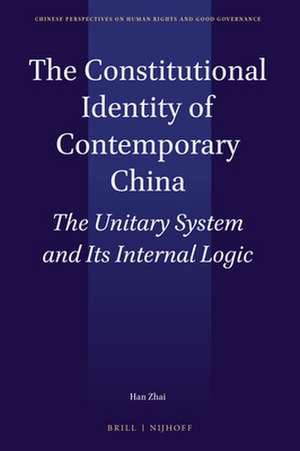The Constitutional Identity of Contemporary China: The Unitary System and Its Internal Logic: Chinese Perspectives on Human Rights and Good Governance, cartea 4
Autor Han Zhaien Limba Engleză Hardback – 18 dec 2019
Preț: 940.83 lei
Preț vechi: 1147.36 lei
-18% Nou
Puncte Express: 1411
Preț estimativ în valută:
180.03€ • 188.44$ • 149.84£
180.03€ • 188.44$ • 149.84£
Carte indisponibilă temporar
Doresc să fiu notificat când acest titlu va fi disponibil:
Se trimite...
Preluare comenzi: 021 569.72.76
Specificații
ISBN-13: 9789004388130
ISBN-10: 9004388133
Dimensiuni: 155 x 235 mm
Greutate: 0.7 kg
Editura: Brill
Colecția Brill | Nijhoff
Seria Chinese Perspectives on Human Rights and Good Governance
ISBN-10: 9004388133
Dimensiuni: 155 x 235 mm
Greutate: 0.7 kg
Editura: Brill
Colecția Brill | Nijhoff
Seria Chinese Perspectives on Human Rights and Good Governance
Cuprins
Foreword
Preface
List of Figures and Tables
Abbreviations
1 Introduction
1.1 Why China and Its 1982 Constitution?
1.2 The Rise of Constitutional Identity: Definition with Interpretation
1.3 Presuppositions, Research Questions and Methodological Approaches
1.4 The Plan of This Book
2 Modern Constitutionalism in China and the Fundamental Structure
2.1 Modern China’s Efforts towards Constitutionalism
2.2 Constitutions of the PRC
2.3 New Characteristics in the 1982 Constitution
2.4 Concluding Remarks
3 Regional Autonomies under the Unitary System
3.1 Regional Autonomy in the Unitary System
3.2 The Hong Kong SAR’s Autonomy under China’s Unitary System
3.3 Mainland China’s National Reunification with Taiwan
3.4 Formal and Informal Constitutional Changes in Taiwan since the 1990s
3.5 Concluding Remarks
4 Reformative Decentralisation and Unsettled Constitutional Centralisation
4.1 Introduction
4.2 Establishing the SEZs
4.3 Dynamic Fiscal Decentralisation before 1994
4.4 The 1994 Tax Reform and Its Evolution
4.5 Centralising the Decentralisation
4.6 Concluding Remarks
5 Constitutional Arrangements and Disharmonies in Comparison
5.1 Introduction
5.2 Temporary Fundamental Designs in the Changing Tides
5.3 Regional Autonomous Arrangements within the 1978 Constitution
5.4 Concluding Remarks
6 Parties and Constitutionalism
6.1 Introduction
6.2 Theoretical Analysis of Political Representation
6.3 ‘Reforming Originalism’ in the Wider Context
6.4 Constitutional Constraints on Political Parties
6.5 Concluding Remarks
7 Two Learned Principles
7.1 Introduction
7.2 Democratic Centralism
7.3 The United Front
7.4 Concluding Remarks
8 Conclusions
8.1 Constitutional Identity of Contemporary China: A System to Unify
8.2 The Unitary System and Its Invisible Parts: Understanding the Logic
8.3 The ‘Reforming’ Constitutions, Disharmonies and Vulnerable Identities
8.4 Evaluating the Unitary System
8.5 Thoughts on the Way Forward
Postscript Notes: On the Ongoing and Unprecedented Recentralisation
Appendix 1
Appendix 2
Selected Bibliography
Index
Preface
List of Figures and Tables
Abbreviations
1 Introduction
1.1 Why China and Its 1982 Constitution?
1.2 The Rise of Constitutional Identity: Definition with Interpretation
1.3 Presuppositions, Research Questions and Methodological Approaches
1.4 The Plan of This Book
2 Modern Constitutionalism in China and the Fundamental Structure
2.1 Modern China’s Efforts towards Constitutionalism
2.2 Constitutions of the PRC
2.3 New Characteristics in the 1982 Constitution
2.4 Concluding Remarks
3 Regional Autonomies under the Unitary System
3.1 Regional Autonomy in the Unitary System
3.2 The Hong Kong SAR’s Autonomy under China’s Unitary System
3.3 Mainland China’s National Reunification with Taiwan
3.4 Formal and Informal Constitutional Changes in Taiwan since the 1990s
3.5 Concluding Remarks
4 Reformative Decentralisation and Unsettled Constitutional Centralisation
4.1 Introduction
4.2 Establishing the SEZs
4.3 Dynamic Fiscal Decentralisation before 1994
4.4 The 1994 Tax Reform and Its Evolution
4.5 Centralising the Decentralisation
4.6 Concluding Remarks
5 Constitutional Arrangements and Disharmonies in Comparison
5.1 Introduction
5.2 Temporary Fundamental Designs in the Changing Tides
5.3 Regional Autonomous Arrangements within the 1978 Constitution
5.4 Concluding Remarks
6 Parties and Constitutionalism
6.1 Introduction
6.2 Theoretical Analysis of Political Representation
6.3 ‘Reforming Originalism’ in the Wider Context
6.4 Constitutional Constraints on Political Parties
6.5 Concluding Remarks
7 Two Learned Principles
7.1 Introduction
7.2 Democratic Centralism
7.3 The United Front
7.4 Concluding Remarks
8 Conclusions
8.1 Constitutional Identity of Contemporary China: A System to Unify
8.2 The Unitary System and Its Invisible Parts: Understanding the Logic
8.3 The ‘Reforming’ Constitutions, Disharmonies and Vulnerable Identities
8.4 Evaluating the Unitary System
8.5 Thoughts on the Way Forward
Postscript Notes: On the Ongoing and Unprecedented Recentralisation
Appendix 1
Appendix 2
Selected Bibliography
Index
Notă biografică
Han Zhai, Ph.D. (2017), Tilburg University, is lecturer of constitutional law and associate research fellow at Wuhan University, China. She holds an LL.M. of the Chinese University of Political Science and Law and an LL.B. of Inner Mongolia University. She is also research fellow at the Israel Institute for Advanced Studies at the Hebrew University of Jerusalem, in the 2019–2020 Research Group 'Constitutional Transplantation.





